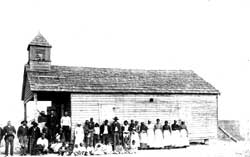 Slave Songs of the United States (1867) from which the three cited examples are taken is not a tunebook. It is include here because it is as near as we can come to a written form of what was an oral tradition of religious music sung by African-American slaves in the period covered by this anthology. Slave Songs was never used as a songbook and was never intended to be used as a songbook. It came into existence as the result of research done by editors William Allen, Charles Ware, and Lucy McKim Garrison who sought to document a colorful genre and style of singing that was being "superseded [in the mid-1800s] by a new style of religious music, closely imitated from the white people. . . . (p. xx)" Armed only with writing materials and a musical ear they did their best to write down what they heard. Slave Songs of the United States (1867) from which the three cited examples are taken is not a tunebook. It is include here because it is as near as we can come to a written form of what was an oral tradition of religious music sung by African-American slaves in the period covered by this anthology. Slave Songs was never used as a songbook and was never intended to be used as a songbook. It came into existence as the result of research done by editors William Allen, Charles Ware, and Lucy McKim Garrison who sought to document a colorful genre and style of singing that was being "superseded [in the mid-1800s] by a new style of religious music, closely imitated from the white people. . . . (p. xx)" Armed only with writing materials and a musical ear they did their best to write down what they heard. The best we can do . . . with paper and types [musical notation], or even with voices, will convey but a faint shadow of the original. The voices of the colored people have a peculiar quality that nothing can imitate; and the intonations and delicate variations of even one singer cannot be reproduced on paper. And I despair of conveying any notion of the effect of a number singing together. . . . There is no singing in parts, as we understand it, and yet no two appear to be singing the same thing. . . . And what makes it all the harder to unravel a thread of melody out of this strange network is that, like birds, they seem not infrequently to strike sounds that cannot be precisely represented by the gamut [the range of musical notation], and abound in "slides from one note to another, and turns and cadences not in articulated notes." (p v, vi) (The entire preface of this work is worth reading.)
The editors state that the three cited examples were sung regularly in church. It seems clear from this testimony that singing the notes printed in these three examples will not produce anything like what the authors of Slave Songs heard. That is why I have not provided a MIDI recording of these tunes. To hear what this heterophonic style of singing might have sounded like, three recordings are recommended: Tongues on Fire: Visions of Ecstasy recorded by the Spiritual Choir of Emmanuel Baptist Church of Winston-Salem, North Carolina (SECCA-Southeastern Center for Contemporary Art-no catalog numbers given), Georgia Sea Island Songs (New World Records 80278-2), and "Po Lazarus" and "Lonsome Valley"on the soundtrack recording for the movie O Brother, Where Art Thou (Lost Highways 088 170-069-2). |
 Slave Songs of the United States (1867) from which the three cited examples are taken is not a tunebook. It is include here because it is as near as we can come to a written form of what was an oral tradition of religious music sung by African-American slaves in the period covered by this anthology. Slave Songs was never used as a songbook and was never intended to be used as a songbook. It came into existence as the result of research done by editors William Allen, Charles Ware, and Lucy McKim Garrison who sought to document a colorful genre and style of singing that was being "superseded [in the mid-1800s] by a new style of religious music, closely imitated from the white people. . . . (p. xx)" Armed only with writing materials and a musical ear they did their best to write down what they heard.
Slave Songs of the United States (1867) from which the three cited examples are taken is not a tunebook. It is include here because it is as near as we can come to a written form of what was an oral tradition of religious music sung by African-American slaves in the period covered by this anthology. Slave Songs was never used as a songbook and was never intended to be used as a songbook. It came into existence as the result of research done by editors William Allen, Charles Ware, and Lucy McKim Garrison who sought to document a colorful genre and style of singing that was being "superseded [in the mid-1800s] by a new style of religious music, closely imitated from the white people. . . . (p. xx)" Armed only with writing materials and a musical ear they did their best to write down what they heard.